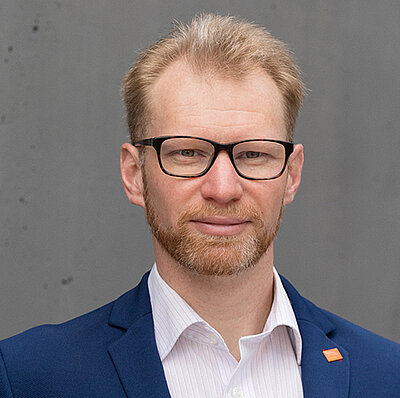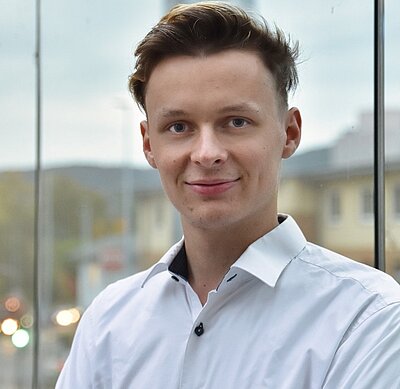DIVING – Digital coupling of multi-scale analyses in modelling and monitoring
The safe operation of built infrastructure is contingent upon the utilisation of robust forecasting models for the purpose of predicting system and structural properties in addition to the implementation of regular or continuous structural monitoring. It is imperative to note that by perpetually adapting the prediction models to the observed actual situation of the structures, deviations in the model assumptions from reality and the presence of either fuzzy or strongly scattering influencing variables can be taken into account in the model. In addition to appropriate metrological structural monitoring, a suitable numerical model is required for this purpose. A multi-scale approach is utilised in this project. In the context of hybrid modelling, the identification of critical areas on the macroscale is predicated on the analysis of monitoring data. These areas are then subjected to detailed forecasts with a significantly higher resolution on the mesoscale. This scale transition is evident in both the experimental techniques, which utilise non-destructive testing methods, and the numerical model.
The establishment of a digital link between the two components is imperative for the purpose of facilitating information flow between the monitoring system and the numerical model. To this end, a theory-driven machine learning approach is being developed. In this manner, a digital link is forged between experimental investigations on the structure and the numerical structural model. Concurrently, the foundation for the regulation of mobile non-destructive measurement technology is established on the basis of the prediction outcomes of the model.
The methodology to be developed includes the creation of numerical multi-scale models, tools for digital coupling, and the experimental investigation of a structure on different scales. The individual components are first analysed on components that are examined in the laboratory under controlled conditions (component tests TKant 1 & 2). In a subsequent step, the methods are validated on reference structures of the SPP100+ (openLAB).

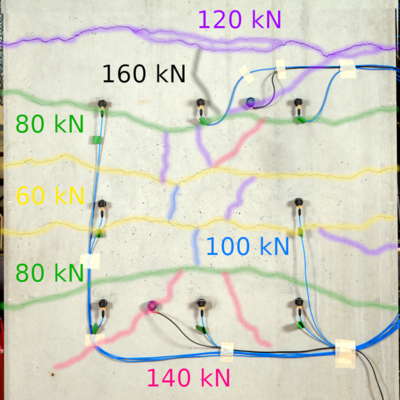
Component test T-Kant 1
In our first component test on 27 September 2023, a precast concrete component was mechanically damaged in stages. Structure-borne noise was recorded during the loads and dynamic measurements were carried out between the loads. Project E01 at TU Braunschweig supplemented the test with optical measurement methods. The experimentally recorded data is used jointly with project C07 of BAM.
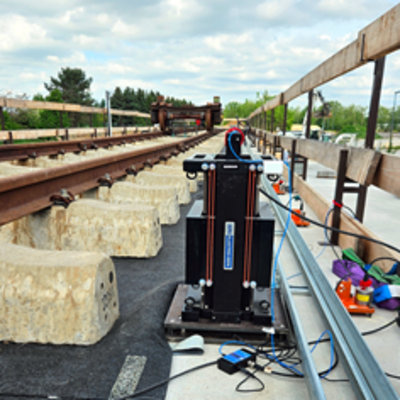
openLAB measurement campaign May 2024
On 2 to 4 May 2024, the openLAB test bridge in Bautzen was recorded by means of structural dynamic measurements using acceleration sensors under both ambient and targeted excitation to record its condition shortly after the structure was built. The measurement serves to prepare a measurement concept for the assessment of planned damage to the structure and as a reference for later comparisons with the current condition.
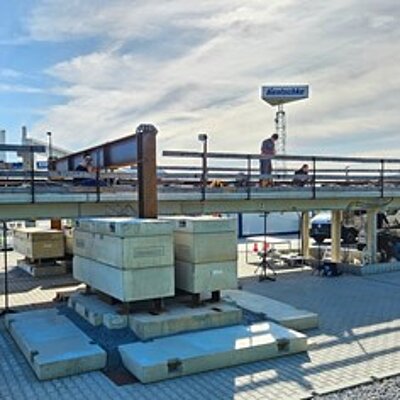
openLAB measurement campaign March 2025
From 24 to 26 March 2025, the dynamic load-bearing behaviour of the openLAB test bridge in Bautzen was recorded again after a one-year service life with regular loads. The tests serve both as a comparison with the condition at the beginning of the structure's service life and as preparation for investigations with the recording of targeted component damage.
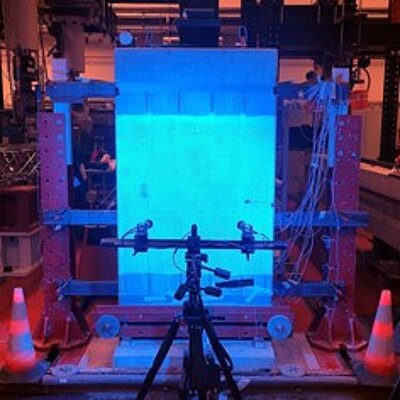
Component test T-Kant 2
The second component test on 14 November 2024 was an extension of the first. Both the number of load levels and the number of acceleration sensors were increased. The crack development was recorded using digital image correlation (DIC) and fibre optic sensors (dFOS). Furthermore, the damaged area was recorded with impact echo and the crack development in the concrete was tracked with acoustic emission. The test concept and the measurement data analysis were carried out in cooperation with the project C03/E03 of the HTWK Leipzig.
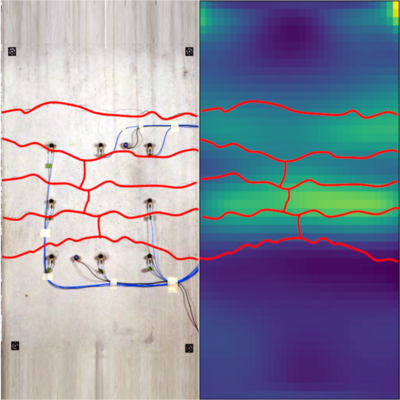
Damage localisation - Modal Strain Energy / Acoustic Emission
A further analysis based on the system identification of the structural dynamic measurements made it possible to identify damage zones. In the modal strain energy method, local changes in the curvature of the eigenmodes of the vibrating component are used to localise the damage. By measuring the structure-borne sound at several sensor positions, the location and time of the crack propagation can be narrowed down locally.
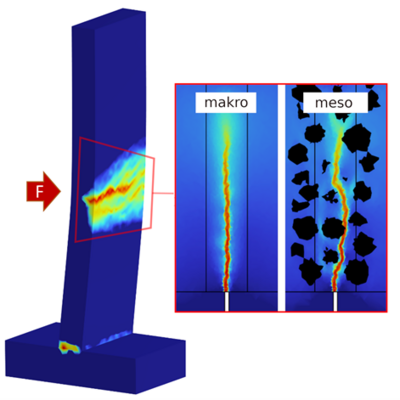
Damage model macro / meso
The measurement data is compared with a damage model to assess the concrete structure. The concrete is broken down into its heterogeneous structure consisting of matrix and aggregates at locations where damage was observed. The model was first validated with benchmark data and is used in the next step to simulate the T-edge tests.

openLAB / IDA-KI large-scale test May 2025
The condition of the openLAB test bridge in Bautzen was recorded intensively before, during and after the large-scale test with damage in May 2025 using dynamic measurements, ultrasonic transmission, fibre-optic sensors and structure-borne sound measurements. Once the data has been analysed, a suitable monitoring concept can be developed. Various universities and research institutes were involved in the large-scale test with a variety of measurement methods.
Science communication:
2023-06-08 FuturING: Tag der Ingenieurwissenschaften, FH Nordhausen
2023-07-14 summaery - SCIENCE MILE Q3, Bauhaus-Universität Weimar
2023-11-24 Vereinigung der Prüfingenieure für Baustatik Landesvereinigung Thüringen, VTE Weimar
2024-07-12 summaery - SCIENCE MILE Q3, Bauhaus-Universität Weimar
2024-11-14 Lange Nacht der Wissenschaften, Bauhaus-Universität Weimar
Contact
Publications
Peer-Reviewed Journal Paper
- Winkler, P., Lippold L., Zabel V., Könke, C. (2024). Damage Detection combining Modal Analysis and Acoustic Emission in Concrete Structures. Procedia Structural Integrity, Volume 64, 2024, Pages 1264-1270, ISSN 2452-3216, https://doi.org/10.1016/j.prostr.2024.09.195
- Becks, H., Lippold, L., Winkler, P., Moeller, M., Rohrer, M., Leusmann, T., Anton, D., Sprenger, B., Kähler, P., Rudenko, I., Arcones, D. A., Koutsourelakis, P.-S., Unger, J. F., Weiser, M., Petryna, Y., Schnellenbach-Held, M., Lowke, D., Wessels, H., Lenzen, A.,…Hegger, J. (2024). Neuartige Konzepte für die Zustandsüberwachung und -analyse von Brückenbauwerken – Einblicke in das Forschungsvorhaben SPP100+/Novel Concepts for the Condition Monitoring and Analysis of Bridge Structures – Insights into the SPP100+ Research Project. Bauingenieur, BD. 99 (2024) Nr. 10. DOI: https://doi.org/10.37544/0005-6650-2024-10-63
- Rohrer et. al. (2025) Experimental Studies on Multi-Scale Data-Driven Methods within the Framework of Strucural Health Monitoring. Civil Engineering Design Wiley. DOI: https://doi.org/10.1002/cend.202400036
Conferences and other publications
- Winkler, P., Lippold L., Zabel V., Könke, C. (2024). Verknüpfung globaler und lokaler Verfahren zur Schädigungsidentifikation am Beispiel einer schrittweisen geschädigten Stahlbetonstruktur. Baustatik – Baupraxis 15, 2024, Technische Universität Hamburg. https://www.bb15.baustatik-baupraxis.de/Anmeldung/Upload/PDF/152715c4.pdf
- Lippold L., Rödiger N., Most T., Könke C. (2024). Identifikation inhomogener Materialeigenschaften von Flächentragwerken mit Physics Informed Neural Networks. Baustatik – Baupraxis 15, 2024, Technische Universität Hamburg. https://www.bb15.baustatik-baupraxis.de/Anmeldung/Upload/PDF/d4174560.pdf
- Winkler, P., Lippold L., Zabel V., Könke, C. (2024). A multi-scale approach for damage identification and condition assessment of built infrastructure. EWSHM 2024, 11th European Workshop on Structural Health Monitoring, Potsdam, Germany, June 10-13, 2024.
- Winkler, P., Lippold L., Zabel V., Könke, C. (2025). Schadenslokalisierung in einer graduell geschädigten Betonstruktur mit der Modal Strain Energy Methode. 8. VDI Fachtagung Baudynamik 2025, Würzburg.
- Schwegmann, L., Paz, C. und Zabel V. (2025). Untersuchungen zur Anwendung eines Schädigungsindikators basierend auf Nullraum-Betrachtungen. 8. VDI Fachtagung Baudynamik 2025, Würzburg.
- Schwegmann, L., Dederichs, A. und Zabel V. (2025). Numerical Considerations in Context of Stochastic Subpace-Based Fault Detection Test. EVACES 2025, Porto, Portugal.
- Paz, C., Schwegmann, L. und Zabel, V. (2025). Identification of Modal Parameters of a Test Bridge under a Moving Mass. 19. D-A-CH-Tagung Erdbebeningenieurwesen und Baudynamik, Wien, Österreich.





